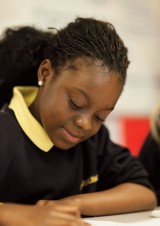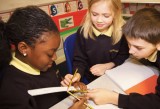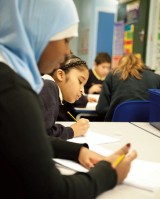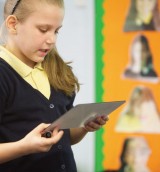Learning your times tables is key to later success in maths, but it needs to go hand in hand with conceptual understanding, says Mike Askew.
A key question still used as a litmus test as to whether one believes in ‘standards’ in mathematics is “should children learn and be fluent in ‘the tables’ or the ‘standard algorithms’ for, say, long multiplication?” But the question assumes that there are two ‘camps’ in mathematics education: those that think such things are important (the ‘procedural’ camp) and those that do not (the ‘conceptual’ camp). In fact, the evidence suggests we need both. Fluency in certain aspects of maths is important but, on its own, it does not guarantee conceptual understanding. On the other hand, conceptual understanding can be hindered if certain processes take up too much working memory, and attention is diverted from thinking about the bigger mathematical picture.
In this article, I look at aspects of fluency that seem to be important, and the role of practice in developing these.
 Fluency covers retrieval of ‘facts’ from memory. This includes being fluent in recalling number bonds spanning addition and subtraction with numbers to 20, multiplication up to 10x10, and associated division facts. Becoming fluent in number bonds includes some memorisation, but it is not only about memory, drill and practice: understanding and reasoning play a big part in becoming fluent.
Fluency covers retrieval of ‘facts’ from memory. This includes being fluent in recalling number bonds spanning addition and subtraction with numbers to 20, multiplication up to 10x10, and associated division facts. Becoming fluent in number bonds includes some memorisation, but it is not only about memory, drill and practice: understanding and reasoning play a big part in becoming fluent.
There is research evidence that being fluent in basic number calculations is strongly correlated with later mathematical success. However, that should not be taken as an indication that drilling children in basic number calculations is the key to developing successful mathematicians. On the other hand, becoming fluent in basic number bonds should not be left to chance; it shouldn’t be assumed that children will eventually come to be fluent without explicitly attending to it.
Other aspects of fluency would include recall of definitions. But fluency goes beyond simply knowing number facts or definitions. Being mathematically fluent also involves choosing methods and procedures and working flexibly. For example, a pupil might mentally calculate 3004 - 2997 by counting on from 2997 to 3004, or decomposing 3004 into 3000 and 4, and using the retrieval of 7 + 3 = 10 to figure out that 2997 + 3 = 3000, so the total difference must be 3 + 4 = 7. Applying a similar approach to 2005 - 8 (counting on from 8 to 2005 or adding 1992 to 8 and then another 5) would not be as fluent. Working flexibly would, inthis latter case, mean counting back, or knowing that a sensible approach is to decompose 8 into 5 + 3, take 5 from 2005 and then subtract 3. Being fluent is not distinct from reasoning about the relationship between the numbers and understanding subtraction both as ‘taking away’ and ‘finding the difference’.
 When children are practising mathematics we need to think about the nature of the practice, as it is not one single type of activity. Practice can take the form of ‘guided practice’, ‘over-practising’ and ‘deliberate practice’.
When children are practising mathematics we need to think about the nature of the practice, as it is not one single type of activity. Practice can take the form of ‘guided practice’, ‘over-practising’ and ‘deliberate practice’.
Guided practice is what children engage in when they are just learning something and are not yet skilled enough to get nearly all of the examples correct without outside help: they need guidance from a more experienced other, usually the teacher, to keep them on track. Once the teacher is satisfied their support can be withdrawn, then children need to move on to over-practising.
Over practising means practising beyond the point where you think you still need to practise. I have a friend who has been a professional violinist for more than 30 years and he still practises his scales every day; the same scales that he started practising when beginning to play the violin at age six. There is truth to the adage ‘use it or lose it’ and we shouldn’t assume that the child who is fluent in recalling the four times table in Y3 is, without continued practice, just as fluent in Y5. Over-practising needs to be little and often: Deal ‘em (see below) s a quick activity for pairs to practise multiplication or division in
spare moments.
Deliberate practice is a term coined by the psychologist Ericsson from the study of expert sportspeople. Ericsson noticed that the nature of practice engaged in was one of the things separating ‘experts’ from the less skilled: the experts kept making what they practised harder to the point of failing, the less successful simply kept repeating what they could already do. This could be thought of as linked to what Carole Dweck describes as the difference between a ‘growth’ and ‘fixed’ view of ability: children she worked with were given tasks to do, some of which were designed to be very difficult, if not impossible. Given the chance to do some of the tasks again, some children chose to do the difficult ones (children with a ‘growth’ view of their ability) others chose to re-do the tasks they had already succeeded at (revealing a ‘fixed ability’ mindset). In maths, we often make practice harder by introducing bigger numbers or reducing the time limit in which to complete a task. I’ve been playing with deliberate practice activities that involve learners in physical actions alongside the maths - shifting attention to the actions means the maths has to become more fluent. ‘Step apart’ (see below) is one such activity.
Ask your colleagues, on their own, to jot down the aspects of mathematics they expect children to be fluent in when they leave their class.
Then get them to jot down what they hope children will be able to do fluently when they come into their class at the beginning of the year.
Small groups made up of teachers with adjacent years of pupils share their fluency expectations and hopes. Is there a good match between what one teacher expects the children to know at the end of the year and what the teacher of the following year hopes children will arrive being able to do?
As a whole staff, draw up a list of minimal fluency expectations for the end of each year.

In pairs, children have a beanbag. They stand facing each other about a metre apart. They agree on the ‘table’ facts they are going to practise - say, the five times table. Player one says a number, “three”, and at the same time tosses the beanbag to player two. Player two has to say the answer to multiplying that number by five as they catch the beanbag. If they succeed, they take a small step back, increasing the gap between themselves and their partner. If they drop the beanbag or give an incorrect answer, or don’t answer in time, they take a small step forward. It’s then their turn to throw a bag and a number at their partner. How far apart can they end up?
Myth: Children need to be fluent in the ‘basics’ before they can reason mathematically
Evidence: There is a relationship between becoming fluent and reasoning, each being supported by the other.
 The exact nature of the relationship between being fluent and reasoning is not entirely clear; for example, it may be that being interested in solving mathematical problems encourages learners to become fluent in basic calculation. But it is clear that fluency, reasoning, problem solving and understanding are intertwined and not related sequentially.
The exact nature of the relationship between being fluent and reasoning is not entirely clear; for example, it may be that being interested in solving mathematical problems encourages learners to become fluent in basic calculation. But it is clear that fluency, reasoning, problem solving and understanding are intertwined and not related sequentially.
Research evidence shows that children use three approaches to answering calculations like 5 + 6 or 13 - 7.
1. Retrieval - simply knowing the answer. Children can recall that 5 + 6 = 11 (three seconds being the benchmark time for retrieval)
2. Counting - either counting all - putting out five objects, another six and counting the total; counting on from one of the numbers - and coming to appreciate that counting on from the larger number is more efficient; or counting back, in the case of subtraction.
3. Decomposition - splitting one or both of the numbers to make use of number facts they can quickly retrieve: thinking of 5 + 6 as 5 + 5 + 1, or double six minus one. Or using 14 - 7 = 7 (from rapid retrieval of doubles) to deduce that 13 - 7 must be 6.
These are not entirely distinct strategies: decomposition can only be used with the aid of retrieval, and the evidence shows there is no clear hierarchy: children will make use of all three. Drilling children to try and improve retrieval doesn’t make them any more likely to use that approach, and often they will be more accurate using a counting method. Contrary to what might seem like ‘progress’, trying to move children on to use only retrieval does not appear to be that effective. Children who use a mix of the methods seem to be most successful.
Pairs of children need a pack of playing cards with the picture cards removed.
Version 1:
A child decides which multiplication facts they want to practise, say, multiplying by seven. Their partner takes cards from the pack, one at a time, and reads the number out. If, before they have silently counted to five, their partner gives the correct answer, the card goes in the ‘correct’ pile, otherwise it goes in a discard pile: that pile is picked up, shuffled and used again, until all the cards are in the ‘correct’ pile.
Version 2:
This version practises the related division facts. Again, a ‘table’ is agreed on. This time the child looking at the card multiples the number they can see by the ‘table’ number (say they are practising sixes, looking at a five the child says ‘30’). Their partner has to say the value of the card. As before, cards are dealt into ‘correct’ or ‘discard’ piles.
Mike Askew is Professor of Primary Education at Monash University, Melbourne. Until recently, he was Professor of Mathematics Education at King’s College, University and Director of BEAM Education.
If your marking doesn’t affect pupil progress - stop it!
Ace-Classroom-Support
Top tips for differentiation
Ace-Maths
